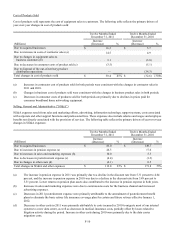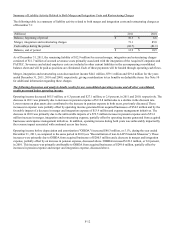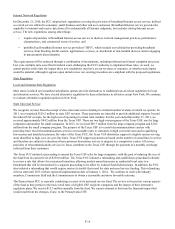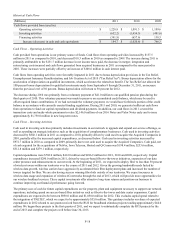Windstream 2011 Annual Report Download - page 124
Download and view the complete annual report
Please find page 124 of the 2011 Windstream annual report below. You can navigate through the pages in the report by either clicking on the pages listed below, or by using the keyword search tool below to find specific information within the annual report.
F-16
Internet Network Regulation
On December 21, 2010, the FCC adopted new regulations covering the provision of broadband Internet access service, defined
as a retail service offered to consumer, small business and other end user customers. Broadband Internet service provides the
capability to transmit and receive data from all or substantially all Internet endpoints, but excludes dial-up Internet access
service. The new regulations, among other things:
• require all providers of broadband Internet access service to disclose network management practices, performance
characteristics, and commercial terms of service; and
• prohibit fixed broadband Internet service providers ("ISPs"), which include our subsidiaries providing broadband
services, from blocking lawful content, applications, services, or attachment of non-harmful devices, and/or engaging
in unreasonable discrimination.
The requirements will be enforced through a combination of mechanisms, including informal and formal complaint processes.
Last year, multiple suits were filed in federal court challenging the FCC's authority to implement these rules. As such, we
cannot predict at this time the impact these new regulations may have on our revenues or expenses, or whether such impact
would be material, although it appears upon initial review our existing procedures are compliant with the proposed regulations.
State Regulation
Local and Intrastate Rate Regulation
Most states in which our incumbent subsidiaries operate provide alternatives to traditional rate-of-return regulation for local
and intrastate services. We have elected alternative regulation for these subsidiaries in all states except New York. We continue
to evaluate alternative regulation options in New York.
State Universal Service
We recognize revenue from the receipt of state universal service funding in a limited number of states in which we operate. In
2011, we recognized $128.5 million in state USF revenue. These payments are intended to provide additional support, beyond
the federal USF receipts, for the high cost of operating in certain rural markets. For the year ended December 31, 2011, we
received approximately $94.2 million from the Texas USF. There are two high-cost programs of the Texas USF, one for large
companies and another for small companies. In 2011, we received $83.7 million from the large company program and $10.5
million from the small company program. The purpose of the Texas USF is to assist telecommunications carriers with
providing basic local telecommunications services at reasonable rates to customers in high cost rural areas and to qualifying
low-income and disabled customers. By order of the Texas PUC, the Texas USF distributes support to eligible carriers serving
areas identified as high cost, on a per-line basis. Texas USF support payments are based on the number of actual lines in service
and therefore are subject to reductions when customers discontinue service or migrate to a competitive carrier. All service
providers of telecommunications services in Texas contribute to the Texas USF through the payment of a monthly surcharge
collected from their customers.
The Texas PUC initiated a proceeding to amend the Texas USF rules for large companies, with the goal of reducing the size of
the fund from its current level of $250.0 million. The Texas PUC initiated a rulemaking and established a procedural schedule
to review a rule that allows for a measured transition, allowing modest annual increases in residential local rates to a
benchmark that will be determined in a separate proceeding to be offset by reduced fund disbursements. In addition, the PUC
also initiated a rulemaking that would require carriers to justify their need for state universal service funding. This rulemaking
will not start until 2013 with an expected implementation date of January 1, 2014. We continue to work with industry
members, Commission Staff and the Commissioners to obtain a reasonable and more favorable outcome.
The Pennsylvania PUC is currently conducting a review of its universal service fund. The review is focused on various aspects
of the fund as they pertain to the basic retail rates of eligible USF recipient companies and the impact of their alternative
regulation plans. We receive $13.3 million annually from the fund. We cannot estimate at this time the financial impact that
would result from the changes, if any, to the Pennsylvania USF.
























